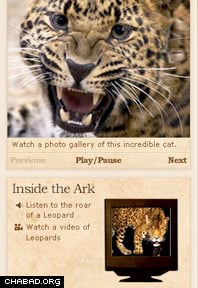For 300 days, Noah, his family and two of every non-kosher species of animal – minus those of the sea – and seven of every kosher one occupied a three-deck ark of wood.
Just what stories did Noah tell his children to pass the time?
The question might be a bit tongue-in-cheek – the Torah records Noah's age at the beginning of the Great Flood as 600; his children were also well grown and married – but nevertheless underscores an important point for Rabbi Mendy Elishevitz: Judaism sees in the animal world many lessons for our own proper behavior.
"The Talmud says that the rabbis learned from animals," says Elishevitz, the creator of the newest section of the Chabad.org Web site, Noah's Ark, which aims to engage children and their parents in a dialogue and exploration of Torah as it relates to the animal kingdom, and vice versa. Chief in the minds of Elishevitz and the Chabad.org development team is to offer an Internet-based Jewish zoo, of sorts.
The launch of the Web page, located at www.chabad.org/noahsark, earlier this week corresponds with this Shabbat's Torah portion, which tells the story of Noah.
"Noah's teivah," says Elishevitz, using the Hebrew word for the ark, "was the first zoo ever. In a way, we're trying to guess what Noah told his kids."
Thus, the entry for the flamingo – which besides featuring high-resolution photographs and a brief description of the tropical water fowl allows users to watch of video of flamingos and hear their calls – teaches about the uniqueness of the G‑dly soul.
"The flamingo has a very distinctive way of feeding – it eats upside down!" reads the first of two "Talking Points." "Our soul, according to Judaism, also bends over backwards: It came from heaven where it was near G‑d and descended into a 'shallow' physical body where G‑dliness is concealed.
"But the trip is promising," continues the lesson. "Through Torah and mitzvot, our soul can achieve great 'profits,' and reach levels that were only a dream beforehand."
Pamela Ehrenkranz, the executive director of the UJA/Federation of Greenwich, Conn., who is credited as the original inspiration for the site, calls Noah's Ark "a wonderful way for children to realize that Judaism has something to say about the animals."
Ehrenkranz says that during a meeting with Chabad.org's executive director, Rabbi Zalman Shmotkin, she brought up the idea of making a trip to the zoo an act of Jewish involvement.
Ehrenkranz sees in the final product a way to connect children to Judaism in a manner that is not overbearing.
"Anything that connects a Jewish child to their faith is inherently a good thing. There need to be multiple doorways to the Jewish world," she explains. "We're in a world where, whether we like it or not, we are constantly having to make Judaism relevant to our kids."
One advantage to the site, she points out, is that most elementary school students are assigned an animal project at some point before Grade 6. That they can now do their research on a Jewish Web site is phenomenal, she asserts.
Nature's Wonderland

While the idea of using animals to illustrate moral lessons may not be entirely new, it was the Sixth Lubavitcher Rebbe, Rabbi Yosef Yitzchak Schneersohn, of righteous memory, who encouraged his aide, Rabbi Nissan Mindel, to publish a series of Torah lessons drawn from examples in nature and geared towards children.
And for 40 years, the Rebbe, Rabbi Menachem Schneerson of righteous memory, would edit Mindel's entries, adding facts, lessons and more. The resulting column, "In Nature's Wonderland," was published by the Kehot Publication Society, the publishing arm of Chabad-Lubavitch, in the children's periodical Talks and Tales.
Elishevitz, still working on more animal entries for the Web page, relies heavily on the Kehot original.
"We're taking these articles and paring them down language-wise to become accessible to a younger audience," says the rabbi, a graphic designer by hobby who also is the associate director of the Chabad House in the Israeli city of Karmiel. "The goal was to keep it short and sweet. We also discovered a bunch of new facts and insights in other sources."
The entry on turtles, for example, references not only Mindel's column, but the Encyclopaedia Britannica, an article on the endangered status of Ghana's marine turtles, and Conservation International's Turtle Conservation Fund.
Noah's Ark also features a children's "Ask Noah" feature, dealing with such issues as the purpose of animals in creation and the idea of animal rights. Special sections for kosher animals and sea creatures are currently in the works.
"The Internet can be a tremendous resource," states Elishevitz. "For children or really anybody who find it difficult to relate directly to certain mitzvot, this is a great way of passing along Torah-true insights."
"We hope that this feature will resonate with children and families and help them discover that Judaism has relevance far beyond the classroom or synagogue," states Elishevitz.
Ehrenkranz says that she finds the site a great resource for adults as well as children.
"I love the idea that a Jewish family could go to a zoo within a Jewish framework because of this site," she asserts. "They can download things from this Web site so that the family can see things not just through childlike eyes of wonder, but through Jewish eyes as well."





Start a Discussion